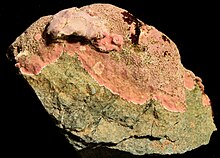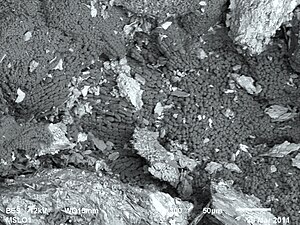Lithophyllum orbiculatum
| Lithophyllum orbiculatum | |
|---|---|

| |
| Lithophyllum orbiculatum from Castalia, Grand Manan Island, New Brunswick, Canada | |
| Scientific classification | |
| (unranked): | Archaeplastida |
| Division: | Rhodophyta |
| Class: | Florideophyceae |
| Order: | Corallinales |
| Family: | Corallinaceae |
| Genus: | Lithophyllum |
| Species: | L. orbiculatum
|
| Binomial name | |
| Lithophyllum orbiculatum (Foslie) Foslie 1900
| |
Lithophyllum orbiculatum is a species of thalloid coralline algae, which are a red algae whose cell walls contain calcareous deposits.
History[edit]
Due to being very similar, the species of coralline algae Lithophyllum crouanii, was often misidentified as Lithophyllum orbiculatum.[1]
Distribution & habitat[edit]
This species is often found in the north of the Atlantic Ocean and in the Mediterranean Sea.[2] It has also been collected in the Indian Ocean more recently.[3] The coralline algae lives in the mid-tide and higher level pools, occasionally exposed to air.[4] The coralline algae mostly grows on hard rock surfaces and was not found on any limestone or slate rock.[4] It can also be found growing on the shells of mollusks that live in the same area, however the algae was physically reduced on the shells.[4] Over time the coralline algae will come together on the surfaces to form large colonies and cover the vast majority of a surface.[4]
Ecology[edit]
The coralline algae often acts as a pioneer that first colonizes new surfaces and prepares it for colonization by other organisms.[4] It sheds its epithallus occasionally in order to prevent other organisms growing over it.[5] Still, it is often overgrown by Lithophyllum incrustans in what is considered ecological succession.[4]
Morphology[edit]
The coralline algae has a rough and chalky texture, and the color can range from grey, brown, and pink. They are thin and will attach very strongly to the surface. The individuals of the species are small, when young the algae's diameter can be up to 8 mm, but when mature the diameter is around 25 mm. Younger specimens will be relatively thin, up to 1 mm thick, with their margins being attenuated and crimped. The mature specimens are thicker and have irregular shapes. Specimens found in areas prone to exposure have thalli that form protuberances that may reach 5 mm tall.[4]
Reproduction[edit]
The coralline algae reproduces during the winter, approximately from October to February.[4] They reproduce using uniporate conceptacles, which are cavities where the reproductive organs of algae are found.[6] The algae may be tetrasporangial, spermatangial, or carposporangial reproduction types. Depending on which type the algae is, the conceptacles will vary in size.[4]
References[edit]
- ^ Chamberlain, Y.M.; Irvine, L.M.; Walker, R. (June 1988). "A redescription of Lithophyllum crouanii (Rhodophyta, Corallinales) in the British Isles with an assessment of its relationship to L. orbiculatum". British Phycological Journal. 23 (2): 177–192. doi:10.1080/00071618800650211. ISSN 0007-1617.
- ^ Aguirre, Julio; Perfectti, Francisco; Braga, Juan C. (2010). "Integrating phylogeny, molecular clocks, and the fossil record in the evolution of coralline algae (Corallinales and Sporolithales, Rhodophyta)". Paleobiology. 36 (4): 519–533. doi:10.1666/09041.1. ISSN 0094-8373. S2CID 85227395.
- ^ Basso, Daniela; Caragnano, Annalisa; Le Gal, Line; Rodondi, Graziella (2015-05-21). "The genus Lithophyllum in the north-western Indian Ocean, with description of L. yemenense sp. nov., L. socotraense sp. nov., L. subplicatum comb. et stat. nov., and the resumed L. affine, L. kaiseri, and L. subreduncum (Rhodophyta, Corallinales)". Phytotaxa. 208 (3): 183. doi:10.11646/phytotaxa.208.3.1. hdl:10281/85441. ISSN 1179-3163.
- ^ a b c d e f g h i Chamberlain, Y.M.; Irvine, L.M.; Walker, R. (June 1991). "A redescription of Lithophyllum orbiculatum (Rhodophyta, Corallinales) in the British Isles and a reassessment of generic delimitation in the Lithophylloideae". British Phycological Journal. 26 (2): 149–167. doi:10.1080/00071619100650121. ISSN 0007-1617.
- ^ Johnson, Craig R.; Mann, Kenneth H. (April 1986). "The crustose coralline alga, Phymatolithon Foslie, inhibits the overgrowth of seaweeds without relying on herbivores". Journal of Experimental Marine Biology and Ecology. 96 (2): 127–146. doi:10.1016/0022-0981(86)90238-8.
- ^ TAYLOR, T (2009), "Introduction to Paleobotany, How Fossil Plants are Formed", Biology and Evolution of Fossil Plants, Elsevier, pp. 1–42, doi:10.1016/b978-0-12-373972-8.00001-2, ISBN 978-0-12-373972-8

